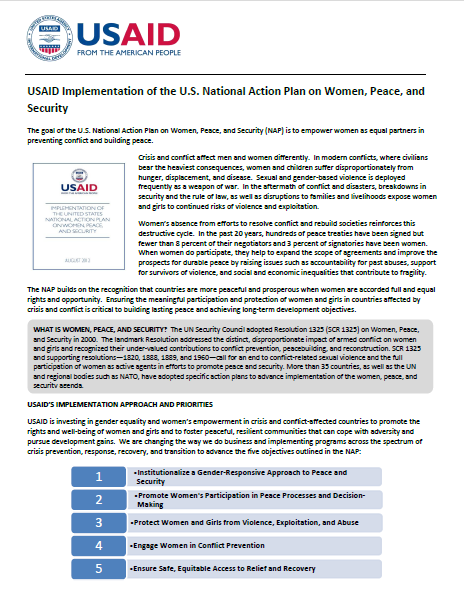Speeches Shim
The goal of the U.S. National Action Plan on Women, Peace, and Security (NAP) is to empower women as equal partners in preventing conflict and building peace.
Crisis and conflict affect men and women differently. In modern conflicts, where civilians bear the heaviest consequences, women and children suffer disproportionately from hunger, displacement, and disease. Sexual and gender-based violence is deployed frequently as a weapon of war. In the aftermath of conflict and disasters, breakdowns in security and the rule of law, as well as disruptions to families and livelihoods expose women and girls to continued risks of violence and exploitation.
Women’s absence from efforts to resolve conflict and rebuild societies reinforces this destructive cycle. In the past 20 years, hundreds of peace treaties have been signed but fewer than 8 percent of their negotiators and 3 percent of signatories have been women. When women do participate, they help to expand the scope of agreements and improve the prospects for durable peace by raising issues such as accountability for past abuses, support for survivors of violence, and social and economic inequalities that contribute to fragility.
The NAP builds on the recognition that countries are more peaceful and prosperous when women are accorded full and equal rights and opportunity. Ensuring the meaningful participation and protection of women and girls in countries affected by crisis and conflict is critical to building lasting peace and achieving long-term development objectives.
USAID'S IMPLEMENTATION APPROACH AND PRIORITIES
USAID is investing in gender equality and women’s empowerment in crisis and conflict-affected countries to promote the rights and well-being of women and girls and to foster peaceful, resilient communities that can cope with adversity and pursue development gains. We are changing the way we do business and implementing programs across the spectrum of crisis prevention, response, recovery, and transition to advance the five objectives outlined in the NAP:
1. Institutionalize a Gender-Responsive Approach to Peace and Security2. Promote Women's Participation in Peace Processes and Decision-Making3. Protect Women and Girls from Violence, Exploitation, and Abuse4. Engage Women in Conflict Prevention5. Ensure Safe, Equitable Access to Relief and Recovery
Institutionalization
- Developing country strategies and program designs that reflect strong gender analyses and clear approaches for advancing gender equality and female empowerment in crisis and conflict-affected countries
- Equipping USAID staff with skills to integrate the protection and empowerment of women and girls throughout the Agency’s work in crisis prevention, response, recovery, and transition
- Tracking our investments in women, peace, and security and monitoring our progress with new foreign assistance indicators
Participation
- Increasing women’s participation and leadership in peacebuilding, reconstruction, and transitional political processes
- Improving the recruitment and retention of women in government and the security sector
- Strengthening civil society’s ability to advocate for the development and implementation of gender-sensitive laws and policies in transitional environments
- Building resilience through assistance that supports women’s roles in the management of natural resources, mitigation of resource-related conflict, and adaptation to climate change
Protection
- Implementing programs to prevent sexual and gender-based violence and the trafficking of vulnerable women and girls in crisis and conflict environments
- Holding U.S. personnel, contractors, and grantees to the highest ethical standards with regard to trafficking in persons
- Targeting underlying norms, attitudes, and behaviors that perpetuate gender-based violence
- Combating impunity and supporting women’s access to justice
Prevention
- Strengthening gender integration in early warning systems and tools to ensure that the different experiences of females and males inform our analyses and approaches to conflict and atrocity prevention
- Engaging women in disaster risk reduction efforts, early warning, crisis planning, and community-based conflict mitigation
- Investing in women’s health, education, and economic empowerment to build stronger societies
Relief and Recovery
- Providing direct support for survivors of sexual and gender-based violence in crisis and conflict-affected communities (medical, psychosocial, legal and economic assistance)
- Engaging vulnerable women and girls in economic recovery activities and supporting their access to education and reproductive healthcare
- Building the capacity of local and international partners to address the protection needs of women and girls
- Increasing USAID’s ability to deliver effective humanitarian assistance for males and females by training staff in humanitarian protection and ensuring access to gender and protection advisors
USAID’s Women, Peace, and Security implementation is coordinated by the Bureau for Democracy, Conflict, and Humanitarian Assistance (DCHA) and the Senior Coordinator for Gender Equality and Women’s Empowerment. An agency-wide working group, including representatives from the field, supports implementation of the NAP and functions as a community of practice to promote learning and best practices within the Agency. To access the NAP and USAID Implementation Plan, go to: http://www.usaid.gov/what-we-do/gender-equality-and-womens-empowerment/addressing-gender-programming/crisis-conflict


Comment
Make a general inquiry or suggest an improvement.